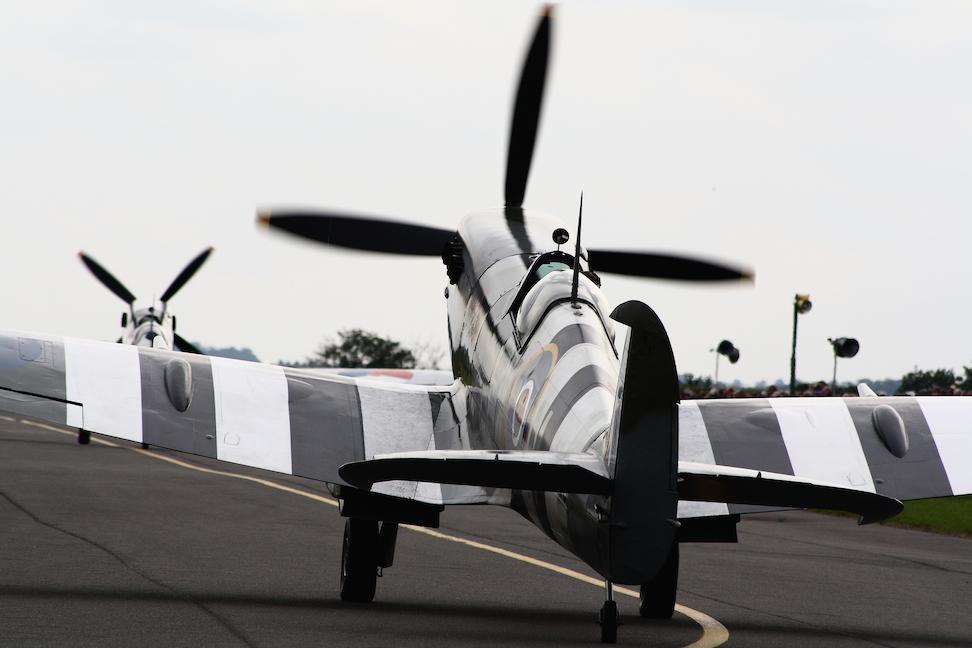The Martin B-26 Marauder was an American World War II twin-engine medium bomber built by the Glenn L. Martin Company.
The first medium bomber in the Pacific theater and Aleutian Islands in early 1942, it was also used in the Mediterranean Theater of Operations and the European Theater of Operations. The plane distinguished itself as "the chief bombardment weapon on the Western Front" according to an US Army Air Forces dispatch from 1946, and later variants maintained the lowest loss record of any combat aircraft during World War II. Its late-war loss record stands in sharp contrast to its unofficial nickname "The Widowmaker" -- earned due to early models' high rate of accidental crashes during takeoff.
A total of 5,288 were produced between February 1941 and March 1945; 522 of these were flown by the Royal Air Force and the South African Air Force.
In 1939, the United States Army Air Corps issued a specification for a twin-engined medium bomber, Circular Proposal 39-640. Six months later, Glenn L. Martin Company presented a design to the US Army Air Corps. Peyton M. Magruder led the design team for this aircraft after Martin won the contract. This design, Martin Model 179, was accepted for production before a prototype even flew, due to the desperate need for medium bombers following the intensification of World War II in Europe.
Once the first aircraft came off the production line in November 1940, Martin conducted tests, the results of which were promising. The first B-26, with Martin test pilot William K. "Ken" Ebel at the controls, flew on 25 November 1940 and was effectively the prototype. Soon after, it was turned over to the Army Air Corps to be service tested. It went from paper concept to working plane in less than two years.
While the B-26 was a fast plane with better performance than the contemporary B-25 Mitchell, its relatively small wing area and resulting high wing loading (the highest of any aircraft used at that time) led to tricky high-speed landings (approach at 140 mph (225 km/h) and stall at 130 mph (210 km/h) indicated airspeed). The R-2800 engines were reliable, but the electric pitch change mechanism in the propellers required impeccable maintenance and was prone to failure. Failure of the mechanism placed the propeller blades in flat pitch with instant total loss of power. Due to the rotund fuselage, the B-26 engines were placed far outboard, and loss of power on one side resulted in a violent snap roll flipping the aircraft on its back. This led to a high number of accidents during takeoff, thus earning B-26 the nickname "Widowmaker" by its pilots. Other colorful nicknames included "Martin Murderer," "The Flying Coffin," "B-Dash-Crash," "The Flying Prostitute," (because it had no visible means of support, referring to the small wings), and "The Baltimore Whore" (a reference to the city where Martin was based).
The toll eventually led to a halt in production. During this time a commission of inquiry (led by then-Senator Harry Truman) was appointed to look into the problem. When Truman and the other commission members arrived at the Avon Park Bombing Range, they were greeted by the still-burning wreckage of two crashed Marauders. Indeed, the regularity of crashes by pilots training at MacDill Field ? up to fifteen in one thirty day period ? led to the only mildly exaggerated catchphrase, "One a day in Tampa Bay."
The resulting aircraft (designated B-26B) had a 6 ft (1.8 m) increase in wingspan, and other changes, some of which reduced the aircraft's speed. The newer version had reduced landing and stall speeds. The safety of the B-26B was an immense improvement: it had the lowest attrition rate of any aircraft used during the war. Nevertheless, it remained a challenging plane to fly and continued to be unpopular with potential crews throughout its life.
General characteristics
Crew: 7: 2 pilots, bombardier, navigator/radio operator, 3 gunners
Length: 58 ft 3 in (17.8 m)
Wingspan: 71 ft 0 in (21.65 m)
Height: 21 ft 6 in (6.55 m)
Wing area: 658 ft² (61.1 m²)
Empty weight: 24,000 lb (11,000 kg)
Loaded weight: 37,000 lb (17,000 kg)
Powerplant: 2× Pratt & Whitney R-2800-43 radial engines, 1,900 hp (1,400 kW) each
Zero-lift drag coefficient: 0.0314
Drag area: 20.66 ft² (1.92 m²)
Aspect ratio: 7.66
Performance
Maximum speed: 287 mph (250 knots, 460 km/h) at 5,000 ft (1,500 m)
Cruise speed: 216 mph (188 knots, 358 km/h)
Landing speed: 104 mph (90 knots, 167 km/h))
Combat radius: 999 nm (1,150 mi, 1,850 km)
Ferry range: 2,480 nm (2,850 mi, 4,590 km)
Service ceiling: 21,000 ft (6,400 m)
Wing loading: 46.4 lb/ft² (228 kg/m²)
Power/mass: 0.10 hp/lb (170 W/kg)
Lift-to-drag ratio: 12.0
Armament
Guns: 12× .50 in (12.7 mm) Colt-Browning machine guns
Bombs: 4,000 lb (1,800 kg)

